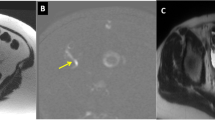Abstract.
The aims of the present study were to assess if MRI gives the same diagnostic information as herniography concerning the presence of hernias and reveals other causes of groin pain. The prospective study enrolled 20 patients referred for herniography, 6 women and 14 men, mean age 48 years. After herniography the patients underwent MRI using T1-weighted, fat-suppressed inversion recovery (STIR), and magnetic resonance cholangiopancreaticography (MRCP) pulse sequences. No contrast medium was administered at MRI. Herniography revealed 11 hernias and MRI depicted 8 of these. Magnetic resonance imaging depicted well the anatomy in the groins. In 3 patients where hernias were not revealed, MRI revealed inflammatory changes in the symphysis region as a possible cause of groin pain. The primary diagnostic tool for diagnosing hernias is herniography. If the herniogram is normal, MRI may reveal other causes of groin pain and may also better visualize related structures in the groin.
Similar content being viewed by others
Author information
Authors and Affiliations
Additional information
Received: 15 February 2000; Revised: 29 May 2000; Accepted: 30 May 2000
Rights and permissions
About this article
Cite this article
Leander, P., Ekberg, O., Sjöberg, S. et al. MR imaging following herniography in patients with unclear groin pain. Eur Radiol 10, 1691–1696 (2000). https://doi.org/10.1007/s003300000555
Issue Date:
DOI: https://doi.org/10.1007/s003300000555




